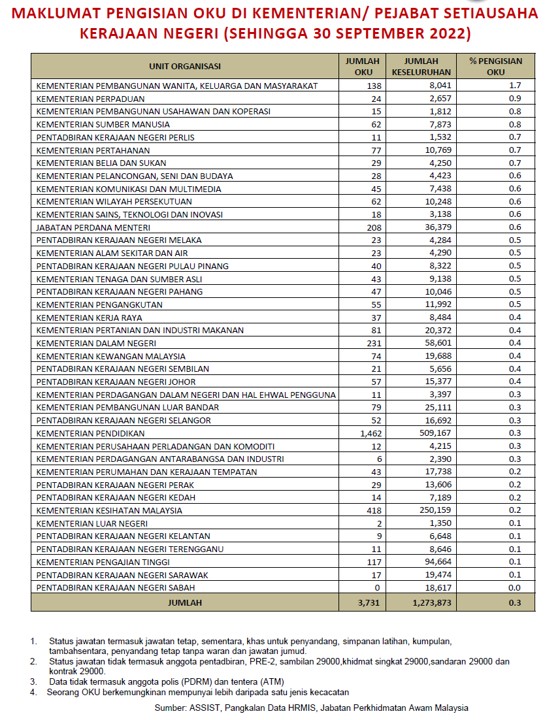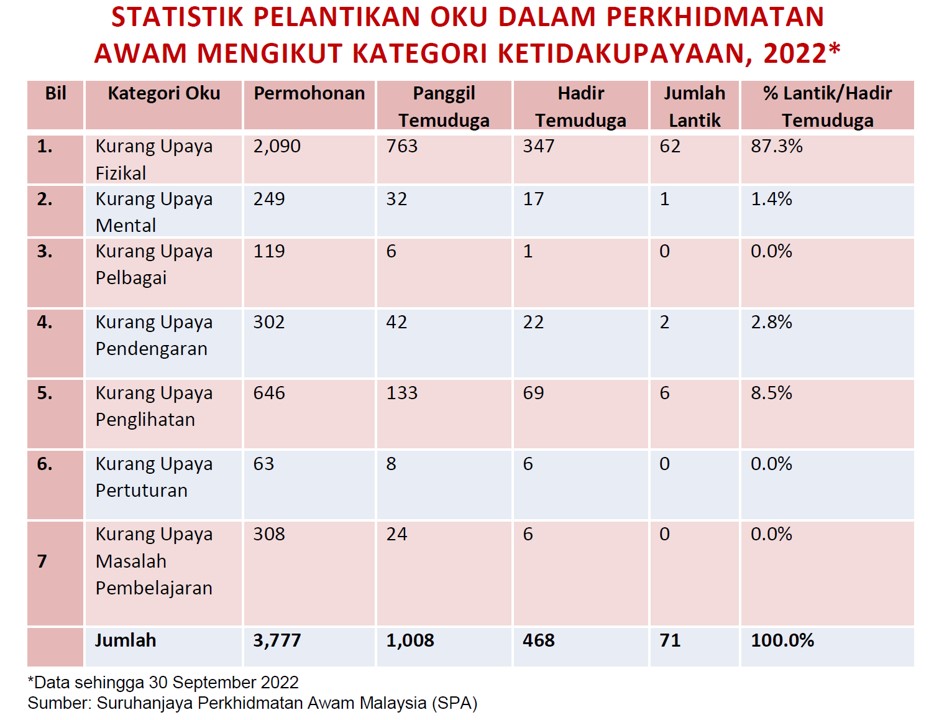Why Has the Government Not Fulfilled Its Promise of 1% Civil Service Jobs for Disabled Persons after 35 years?


By Dato’ Dr Amar-Singh HSS
The recent statement in Parliament by the Human Resources Minister on “very few cases” of workplace discrimination faced by persons with disabilities has led us to question: Why has the Government not fulfilled its promise of 1% civil service jobs for disabled persons?
The government policy target has existed since 1988: 1% of the employees in the civil service should be persons with disabilities. Now, 35 years later, this promise has not even come close to being achieved. As of September 2022, only 0.3% of the civil service are persons with disabilities. Some ministries have very poor rates of only 0.1 to 0.2% (see Image 1).


Hence, we need to ask why? Why the significant failure after 35 years?
Suruhanjaya Perkhidmatan Awam (SPA) data show that, for the year 2022 (data as of September 2022), of 3,777 civil service job applications by persons with disabilities, only 1,008 (27%) were called for an interview (see image 2). This clearly shows the high level of rejection of persons with disabilities at the application phase, even before they have a chance to be interviewed. We need to ask: What were the reasons for all these rejections? Were they not qualified for the job? Was there discrimination? What was done to support all those rejected in getting employment? Presumably, only those who met the academic criteria applied.
Even more dismal is the employment rate. Of the 3,777 applicants, only 71 (1.9%) were employed. The following are noteworthy:
- The rate of employment of those who came for an interview was 71/468 or 15%.
- Rates of employment for persons with learning disabilities, persons with speech or hearing disabilities and persons with psychosocial disabilities were much lower than those of persons with physical or visual disabilities. There could be discrimination by type of disability.


After 35 years of policy implementation failure, the time has come for an audit of the government employment process of persons with disabilities. This must examine, among others, pre-employment, including vacancy announcements and recruitment, as well workplace attitudinal orientation and other reasonable accommodation in the civil service. The design and implementation of this audit must be fully supported by Government and be led by disability rights advocates and organisations who have the necessary networks, to examine the reasons for the 35-year failure and how Malaysia can advance on this matter.
The national Pelan Tindakan OKU 2018–2022 includes the establishment of an audit access team to ensure workplace accessibility and reasonable accommodations, in alignment with the 1% civil service employment quota. However, this vital initiative remains unfulfilled. In addition, a target KPI of at least 3 ministries with 1% OKU by 2018 was set. Unfortunately, only one ministry, the Ministry of Women, Family and Community Development fulfilled this KPI as of 2022. The lack of accountability and monitoring regarding the implementation of such measures poses a significant challenge. Without acknowledgement of failure and the will to pursue a comprehensive approach to policy and plan adherence and accessible workplaces, Malaysia will continue to fall short in meeting its own 1% quota of civil service jobs for persons with disabilities.
Equally essential is the need to ensure the accessibility of information related to hiring processes, accommodating diverse needs such as the following:
- Braille for Blind persons;
- Screen-reader accessible government websites, apps and e-Government forms and other documentation that are compliant with Web Content Accessibility Guidelines (WCAG) for Blind persons and persons with other print disabilities;
- Bahasa Isyarat Malaysia (BIM) interpretation services for Deaf persons;
- Easy-Read or Plain Language for persons with intellectual or learning disabilities or cognitive impairments.
Neglecting to provide information in formats that diverse disability groups can access constitutes discrimination at the very outset of the selection process.
With 16% of the population having a disability, it is unwise to ignore this potential workforce. We hope that the Government will take concerted action to fulfil a long standing promise made to persons with disabilities.
Thank you.


